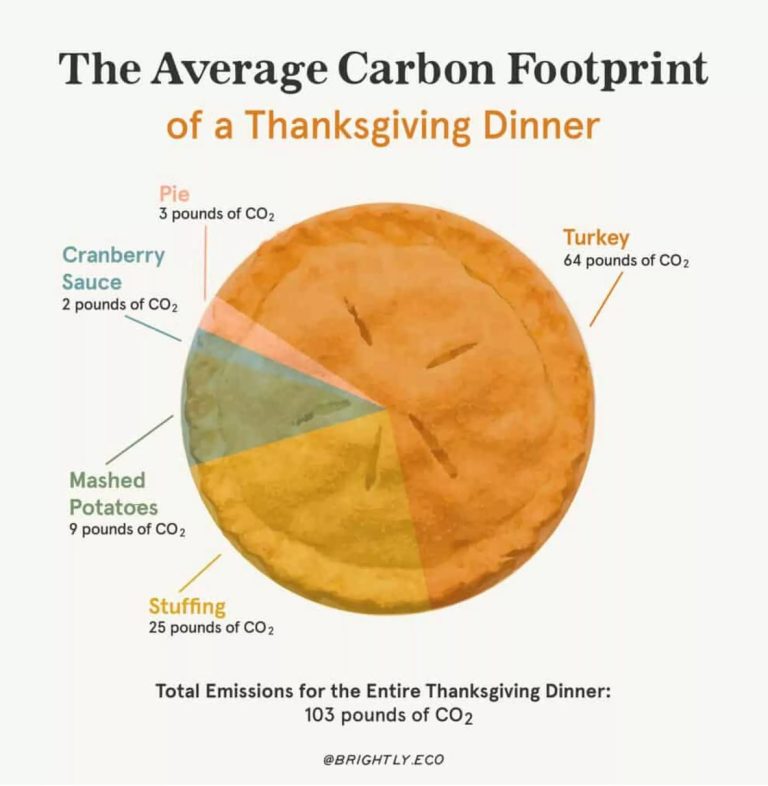Thanksgiving celebrations differ nationwide, yet the classic turkey feast remains a common theme. Unfortunately, it carries a significant carbon footprint.
For Europeans, ‘Thanksgiving’ has never been quite fully understood. Our knowledge of American history is limited, and so our knowledge of the festivities largely comes from watching ‘Friends’ reruns. You know the one where Monica walks around with a turkey on her head. Thanksgiving might look a little different depending where you are in the states and how your family chooses to celebrate, but for most Americans the centerpiece is often a complete turkey with all the trimmings. By trimmings we mean pork stuffing, mashed potatoes, cranberry sauce, and pie. In fact, according to eco brightly, 81% of Americans will follow this national tradition. Using this as a benchmark, they have estimated that the average carbon footprint of a Thanksgiving dinner is approximately 103 pounds of CO2. (Equivalent to 0.0515 tons.)

How Many Turkeys are Eaten on Thanksgiving?
In 2022, more than 210 million turkeys were raised on some 2,500 farms across the United States, according to the National Turkey Federation. Many of those turkeys will be on the table at Thanksgiving, as the U.S. Department of Agriculture estimates that Americans consume more than 46 million turkeys on Thanksgiving Day each year.
So multiplying the carbon footprint of a Thanksgiving dinner by 46 million americans who are likely to be dining in the same way, you are looking at an increase of 2,369,000 tons of CO2, just over the Thanksgiving period and just on dinner! This figure doesn’t include all of the additional aspects which add to increased emissions over this festive season.
Breaking Down The Carbon Footprint of Thanksgiving
As families across the nation prepare to gather for the annual Thanksgiving feast, it’s time to take a closer look at the environmental impact of these cherished traditions. From the turkey on the table to the miles traveled to be with loved ones, the carbon cost of Thanksgiving is more significant than we might realize.
Thanksgiving, a time of gratitude and feasting, brings with it a series of considerations regarding its environmental impact. The journey of the Thanksgiving centerpiece, the turkey, is marked by the significant carbon footprint of mass farming operations. These operations contribute substantially to greenhouse gas emissions and place a strain on vital resources like water and land.
The expansive nature of Thanksgiving feasts often involves the sourcing of ingredients from distant corners of the globe, leading to a considerable carbon cost associated with food transportation. Shipping foods over long distances and importing out-of-season produce contribute to the overall environmental impact of our holiday meals.
Additionally, the festivities surrounding Thanksgiving generate a concerning amount of food waste, a key contributor to methane emissions in landfills. In tandem, the reliance on disposable plates, utensils, and packaging contributes to the vast amounts of waste generated during the holiday.
How to Make Thanksgiving Dinner More Environmentally Friendly.
Mindful Menu Planning and Waste Reduction Strategies
Consider opting for a more sustainable Thanksgiving menu. Explore plant-based alternatives for traditional dishes or choose locally sourced, organic ingredients. Not only does this reduce the carbon footprint associated with food production and transportation, but it also supports local farmers and promotes a healthier, more environmentally friendly way of eating. Why not also Implement strategies to minimize food waste. Plan your menu carefully, portion control, and get creative with leftovers. Consider composting food scraps rather than sending them to landfills.
Eco-Friendly Decorations
When it comes to setting the Thanksgiving table, opt for reusable or biodegradable decorations. Consider using natural elements like leaves and gourds instead of plastic or disposable items. Embracing sustainable decor adds a touch of eco-consciousness to your celebration.
Carbon Footprint Awareness and Education
Take the initiative to identify and measure your carbon footprint. Online tools such as our free carbon footprint calculator can help you calculate the environmental impact of your Thanksgiving festivities. Understanding your carbon footprint empowers you to make informed choices about where and how you can reduce your environmental impact.
Offsetting Emissions with Climate Donations
Consider offsetting the additional emissions generated over Thanksgiving by making a climate donation. Platforms like our online Marketplace provide a direct and impactful way to contribute to climate action. When you make a climate donation, you can support projects that actively work to reduce or capture carbon emissions.
How to Include Climate Action in your Thanksgiving Celebration.
The Climatetrade Marketplace offers a unique opportunity to make a tangible difference in the fight against climate change. With the world’s largest portfolio of projects, ClimateTrade empowers individuals and businesses to take direct climate action in real time.
Our approach allows you to take direct climate action, contributing to projects that have a positive impact on the environment. Whether it’s supporting wind energy initiatives, forest conservation, or community-based sustainability projects, your climate donation through our climate action platform can become a meaningful part of your Thanksgiving celebration, as well as a way to raise awareness with friends and family over the importance of climate consciousness.
According to Google trends, there has been an increase in 400% of Americans searching for information on the impact on Turkeys over Thanksgiving, In addition to 130% increase in Americans looking for information on Climate mitigation topics. So although it might seem that not much is changing, we firmly believe that families in the US will start to look for ways to lower their impact during this time of year. Whether that’s forgoing a Turkey Thanksgiving Dinner or simply choosing not to get caught up in the unnecessary purchasing that takes place over Black Friday. This Thanksgiving we invite you to be a champion of change at your dining table and put the well-being of the environment first.








